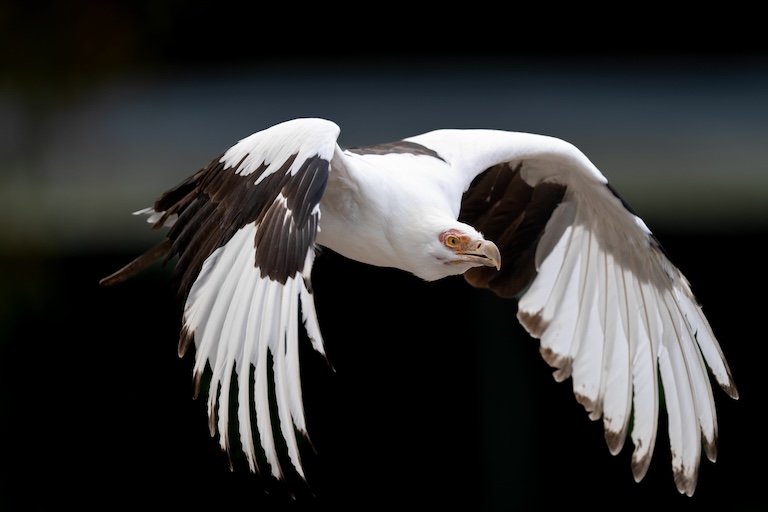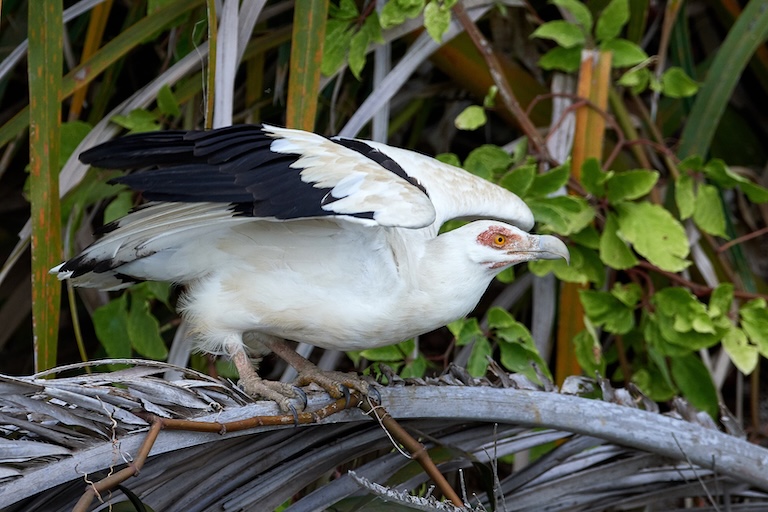Palm-Nut Vulture Profile
The Acciptrids are a family of raptors with a long and convoluted taxonomic history. These are the Old-World raptors, and members include most of the eagles, vultures, hawks, harriers, and so on, especially those found outside of the Americas.
But drawing lines between the various subtaxa has proven difficult, and animals like the palm-nut vulture are a great example of why.
Here’s a vulture that looks like an eagle and eats like a fruit bat.

Palm-Nut Vulture Facts Overview
| Habitat: | Forest and Savanna, near water |
| Location: | Sub-Saharan Africa |
| Lifespan: | Around 27 years in captivity |
| Size: | 60 cm (2.0 ft) long, with a 1.50 m (4.9 ft) wingspan |
| Weight: | 1.7 kg (3.7 lb) |
| Colour: | White up top, black below, pink face |
| Diet: | Palm fruits, fish, crabs, turtle eggs, amphibians, insects |
| Predators: | Few, juveniles and eggs may be eaten by snakes, birds, arboreal mammals |
| Top Speed: | Not listed |
| No. of Species: | 1 |
| Conservation Status: | Least Concern (IUCN) |
Palm nut vultures are the smallest of the true vultures and look remarkably similar to the larger fish eagle, rather than others of its kind.
They seem to reject much of what vultures are known for but don’t really compare much to other raptors, either, preferring fruit over any particular meat, and enjoying a quiet and sedentary life in palm nut plantations and by tropical lakes.
This means they have very few enemies and are doing fairly well as a species in a world where so many Accipitrids are struggling. Still, as raptors, the struggle to adulthood is real and the vast majority don’t make it.
Interesting Palm-Nut Vulture Facts
1. They look like eagles
The palm-nut vulture is one of the easiest birds to recognise, being similar only to the African fish eagle, which, for a vulture, is quite unusual.
It’s a small vulture, at less than 2 kg, and the smallest of the Old World vultures. It sits, like the fish eagle, perched above lakes, on the top of trees, and even in flight, looks unlike other vultures, and more like the eagles it shares its habitat with.
Again, like the fish eagle, the males and females look pretty much alike, but the face and overall colour of the bird give it away. A pink or red eye patch, chunkier beak and longer head set it apart from the eagles, as do the white shoulders and lack of rusty red belly, though these features are unreliable or absent in juveniles.
Unlike the eagles, male and female palm-nut vultures are the same size, and quite unlike almost any raptor, they have a hankering for fruit.
2. They have a weird diet
It should be apparent already that this is not a conformist vulture species. Perhaps it’s a wannabe eagle in appearance, but in behaviour, it’s pretty much unique.
Vulture species across Africa, and really all over the world, have tanked on account of the toxicity of livestock medicines, but the palm-but vulture has an advantage, as it gets around half of its diet from fruits.
So, while the fish eagle is scanning for prey (or more often than not, scanning to steal fish from other predators), the palm-nut vulture is conserving energy by feeding on palm fruits around the same lakes.
But it’s not a fussy eater. As a raptor, this vulture is also happy with flesh and will eat carrion, live fish, crabs, and other small animals it can get its beak around. One population showered a preference for green turtle eggs, and others have been seen to eat rats and mice.
Raw, unrefined palm oil is a distinctly red-coloured liquid, and this is caused by a huge concentration of carotenes, a healthy form of pigment, and likely a source of sexually attractive colouration in the bird’s orange eyes.
3. They love water
Another reason for the confusion between the vulture and the eagle is that they both appreciate a good lake view. Palm-nut vultures spend lots of time around water and love to bathe and drink from lakes.
They’ve also been seen lying down in the mud, something which the proud fish eagle would never be seen doing.
4. Forward and down
Raptors are commonly seen engaging in various forms of aerial acrobatics, but the palm-nut vulture has its own set of ritual displays that are distinct from other birds.
This specific postural routine is called the “Forward-and-down display”, and the female has been seen using it as a territorial defence posture, and again when displaying dominance when with her mate.
She accompanies this motion of her head and neck with a growl or bark, the message of which isn’t entirely clear.
Interestingly, the male uses the same technique to suggest that the female approaches for mating, and for this purpose, the vultures engage in acrobatic flight displays involving rapid stoops from great heights, though these are rarely seen.

5. They do OK in palm oil plantations
Unsurprisingly, the increase of palm oil monocultures in Africa has been quite the boon for the vulture that feeds on their fruits. As of yet, they aren’t commonly considered a pest species, and being no competition to local fishermen, they’re generally left alone, although persecution does occur in some regions.
And of course, feeding much less on carrion means they’re not at so much risk of poisoning from Diclofenac.
Habitat loss does still present a challenge in areas where the expansion of palm plantations isn’t a factor, but as of yet, they’re still a species of Least Concern to the IUCN.
That’s not to say they have it easy, though!
6. They still struggle
Conservation statistics are looking at the species as a whole, and are not overly concerned with the plight of the individuals.
That’s because, in a balanced ecosystem, animals and plants have evolved counter-measures to adjust for whatever struggles they have, ensuring that despite losses, the species moves forward.
So, you can have animals for whom the vast majority are killed before they can reproduce but the species as a whole is doing fine. And this is the case with the palm-nut vulture.
This bird’s species has a roughly 87% mortality; adults lay a single egg in a season and almost all of the offspring die within the first four years.
This issue is compounded in areas where the human population persecutes the birds, as is the case in Lesotho, where they are occasionally poisoned deliberately, or in South Africa, where they’re poisoned unintentionally.
So, the life of a palm-nut vulture is fraught with challenges, like most bird species, but for now, the population appears to be stable.

Palm-Nut Vulture Fact-File Summary
Scientific Classification
| Kingdom: | Animalia |
| Phylum: | Chordata |
| Class: | Aves |
| Order: | Acipitriformes |
| Family: | Accipitridae |
| Genus: | Gypohierax |
| Species: | angolensis |
